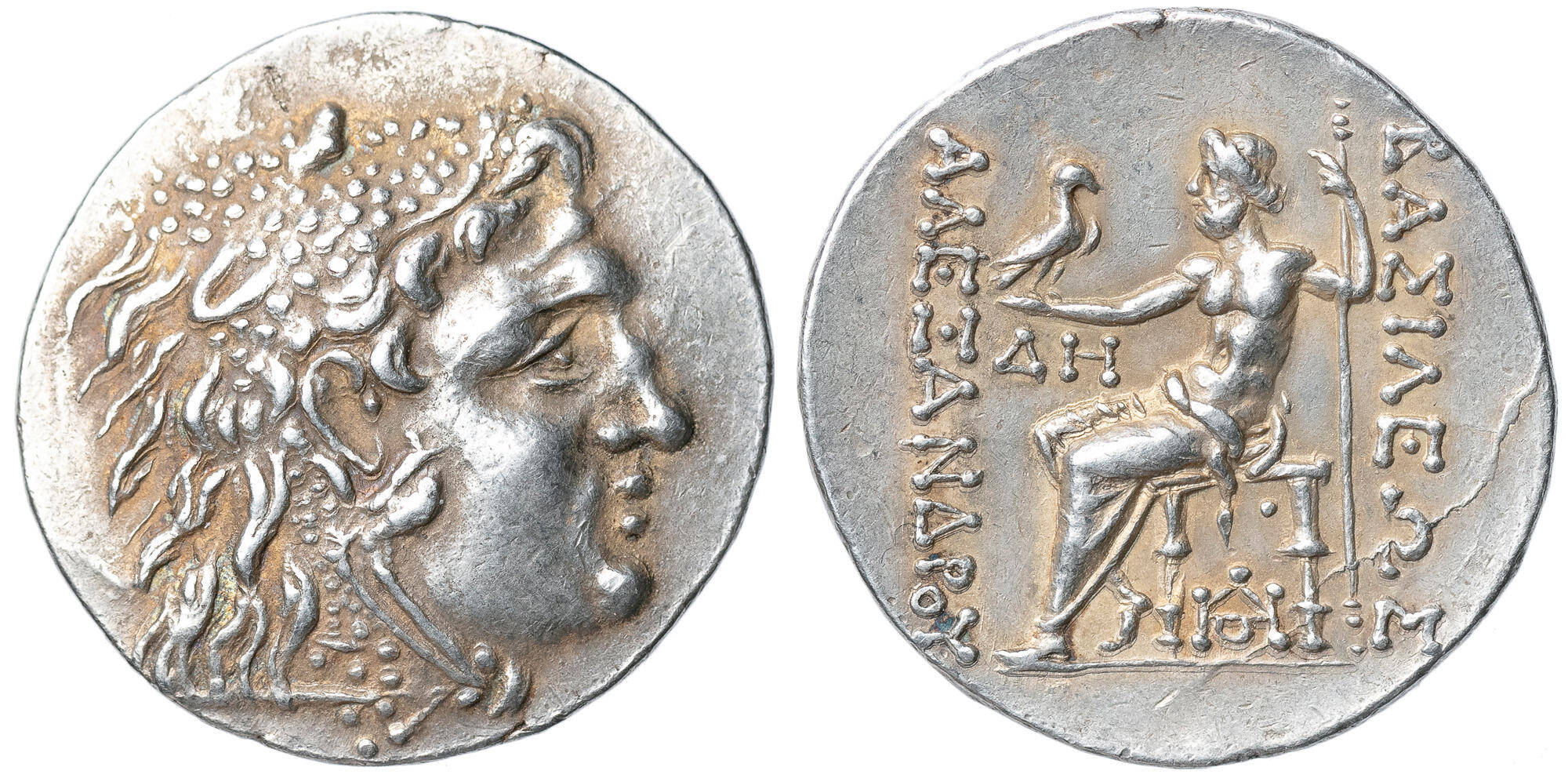Odessus (Alexander the Great), silver, tetradrachms (130-80 BCE)
From SILVER
130 BCE - 80 BCE Silver 12,708 kg
Description
| ObverseInscription or printing placed on the obverse.: | Head of Heracles right, wearing Nemean lion skin headdress. |
| ReverseInscription or printing placed on the reverse.: | ΒΑΣΙΛΕΩΣ ΑΛΕΞΑΝΔΡΟΥ (Greek).Zeus enthroned left, holding Nike and sceptre |
Mint and issuing power
| MintIdentifies the place of manufacture or issue of a numismatic object.: | Odessus | Ancient regionAncient region.: | Thrace | Modern countryModern country: Bulgaria | AuthorityIdentifies the issuing power. The authority can be "pretended" when the name or the portrait of X is on the coin but he/she was not the issuing power. It can also be "uncertain" when there is no mention of X on the coin but he/she was the issuing power according to the historical sources: | Alexander III the Great (Argead king, 336-323 BC) |
Chronology
| FromIdentifies the initial date in a range assigned in a numismatic context. | 130 BCE | toIdentifies the final date in a range assigned in a numismatic context.. | 80 BCE | PeriodTime period of the numismatic object.: Hellenistic 323-30 BC |
Physical description
| MetalThe physical material (usually metal) from which an object is made.: | Silver |
Median weightMedian of the weights of numismatic objects (in grams). in grams | 16.50 | DenominationTerm indicating the value of a numismatic object. Examples: tetradrachm, chalkous, denarius.: | tetradrachm |
StandardStandard.: | Attic |
Image

RQEMH 61 - Odessus, silver, tetradrachm, 130-80 BC.jpg [1]
References
| Die study referencePublication of the study: | Callataÿ 1994b1Callataÿ 1994b | ||
| Coin series referenceReference to coin series study: | RQEMH2RQEMH, n° 61, Price 19913Price 1991, n° 1177-1210, HGC 3.24HGC 3.2, n° 1584-1589 | ||
| Coin series web referenceCoin series web references: | |||
Obverse dies distribution
| FrequencyFrequency of specimen in distribution. ᵖ | Number of obversesNumber of obverse dies. ᵖ (o) | % (o) | Number of coinsNumber of coins. (n) | % (n) | Die nameName(s) of the die(s). |
| 1 | 7 | 19.44 | 7 | 3.1 | 1/3, 1/7, 2/3, 2/6, 2/9, 2/10, 2/11 |
| 2 | 2 | 5.56 | 4 | 1.77 | 1/15, 1/16 |
| 3 | 9 | 25 | 27 | 11.95 | 1/1, 1/9, 2/4, 2/5, 2/7, 2/8, 2/12, 2/13, 3/1 |
| 4 | 4 | 11.11 | 16 | 7.08 | 2/1, 2/2, 2/4, 3/6 |
| 5 | 1 | 2.78 | 5 | 2.21 | 3/3 |
| 6 | 1 | 2.78 | 6 | 2.65 | 1/5 |
| 7 | 2 | 5.56 | 14 | 6.19 | 1/13, 2/4 |
| 8 | 2 | 5.56 | 16 | 7.08 | 1/4, 1/6 |
| 9 | 2 | 5.56 | 18 | 7.96 | 3/2, 3/5 |
| 12 | 1 | 2.78 | 12 | 5.31 | 1/14 |
| 13 | 1 | 2.78 | 13 | 5.75 | 1/8 |
| 15 | 1 | 2.78 | 15 | 6.64 | 1/10 |
| 21 | 1 | 2.78 | 21 | 9.29 | 1/12 |
| 25 | 1 | 2.78 | 25 | 11.06 | 1/11 |
| 27 | 1 | 2.78 | 27 | 11.95 | 1/2 |
| Total | 36 of 36 | 100.03 | 226 of 226 | 99.99 |
Reverse dies distribution
no distribution is available
Quantification
| Number of obversesNumber of obverse dies. ᵖ (o) | 36 | Number of singletons (o1)The number of singleton coins. ᵖ | 7 |
| Number of reverse diesNumber of reverse dies. (r) | 111 | Number of coinsNumber of coins. (n) | 226 |
| Coins per obverse dieNumber of coins per obverse die. (n/o) | 6.28 | Coins per reverse dieNumber of coins per reverse die. (n/r) | 2.04 |
| Reverse per obverse ratioRatio of obverse dies divided by reverse dies. (r/o) | 3.08 | Percentage of singletons (o1)number of coins (n) divided by the number of singletons (o1) ᵖ | 19.44 % |
| Original number of dies (O) (Carter 1983 formula)The estimation of the number of coins according to Carter 1983 ᵖ | 38.51 | Coins struck if 20,000 as average productivity per dieCoins made if the average productivity for obverses (according to Carter) is 20,000. ᵖ | 770,200 |
| Original number of dies (O) (Esty 2011 formula)The estimation of the number of coins according to the singleton formula in Esty 2011 ᵖ (O) | 42.82 | Survival rate if 20,000 as average productivity per dieSurvival rate if average productivity is 20,000. ᵖ | 0.00029 |
| Coverage (o = % of O) (Esty 1984 formula)Esty 1984 - coverage (% of O) ᵖ (o = % of O) | 96.9% | Die productivity if survival rate 1/2,000Average productivity if survival rate is 1/2,000. ᵖ | 11,737.21 |
| Weight of silver (in kg) if 20,000 coins per die (O = Carter formula)Carter 1983 * Median weight * 20000 (*10 if gold or electrum) ᵖ | 12,708 kg <br /> 12,708 kg | Die productivity if survival rate 1/5,000Average productivity if survival rate is 1/5,000. ᵖ | 29,343.03 |
Remarks
Most likely one single workstation Likely military
References
- ^ Callataÿ, François de (1994), "Les derniers alexandres posthumes frappés à Odessos et Mésembria", in Settlement Life in Ancient Thrace. IIIrd International Symposium "Cabyle", 17-21 May 1993, Jambol (Bulgaria), p. 300-342
- ^ Callataÿ, François de (1997), Recueil quantitatif des émissions monétaires hellénistiques, Numismatique Romaine, Wetteren, X + 341 p.
- ^ Price, Martin Jessop (1991), The Coinage in the Name of Alexander the Great and Philip Arrhidaeus: a British Museum Catalogue, 2 vol., Zürich-London, 637 p., 637 p., clix pl.
- ^ Hoover, Oliver D. (2017), Handbook of Coins of Macedon and Its Neighbors. 3. Part 2: Thrace, Skythia, and Taurike, Sixth to First Centuries BC, Lancaster-London, xix, 232 p.